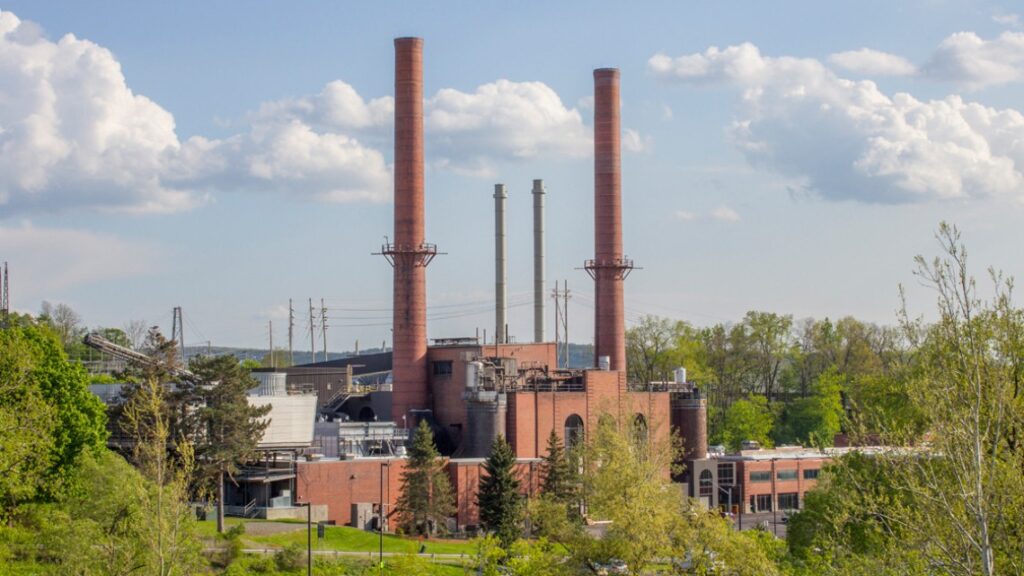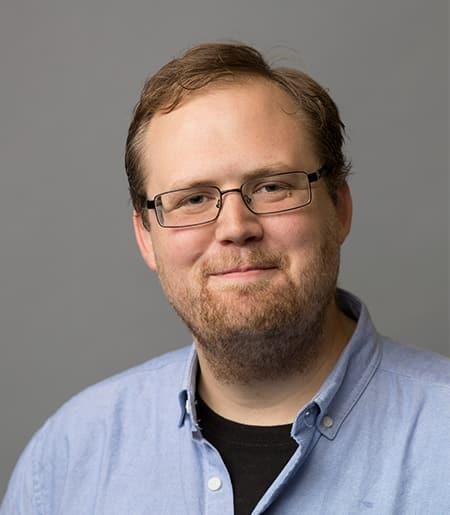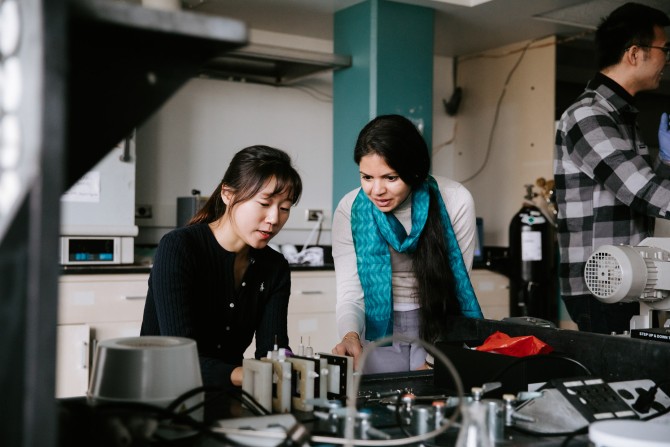What you need to know about carbon capture, utilization and storage
The experimental facility will explore carbon capture, utilization or storage, and industrial decarbonization, and it will be sited at Cornell’s existing Combined Heat and Power Plant

To contain the damage of climate change, reducing emissions and switching to renewable energy sources will not be enough. Removing some of the excess carbon dioxide warming our planet is critically important; however, current methods for human-directed carbon capture are expensive and inefficient. To support the development of new carbon capture technologies, nine Cornell researchers are establishing the Cornell Advanced Platform for Testing, Utilization, and REsearch in CO2 capture and conversion technologies (CAPTURE-Lab).
The experimental facility will explore carbon capture, utilization or storage, and industrial decarbonization, and it will be sited at Cornell’s existing Combined Heat and Power Plant to give researchers access to real-world flue gas emissions. Three researchers leading CAPTURE-Lab development and research on carbon capture, utilization and storage are Tobias Hanrath, the David Croll Professor in Engineering in the R.F. Smith School of Chemical and Biomolecular Engineering, Phillip Milner, associate professor of chemistry and chemical biology in the College of Arts and Sciences and a field member in the R.F. Smith School of Chemical and Biomolecular Engineering, and Greeshma Gadikota, associate professor in the School of Civil and Environmental Engineering.
Ben Furnas, visiting senior fellow at Cornell Atkinson and former executive director of the 2030 Project: A Cornell Climate Initiative, interviewed Gadikota, Hanrath and Milner about their research and goals for the CAPTURE-Lab.

Furnas: What is carbon capture and industrial decarbonization? What is the challenge we’re trying to solve?
Hanrath: A little over 100 years ago, CO2 levels were about 300 parts per million (ppm) in the atmosphere. When I was young in the 1980s, CO2 levels were at 340 ppm. Today, they’re at 425 ppm. CO2 levels have increased that much in just the span of two generations. The pressing questions are what these levels might be in two more generations, and what we’re doing about this now to proactively remove a lot of CO2, very quickly.
Milner: About two-thirds of all greenhouse gas emissions come from combustion of fossil fuels for energy production. We can’t switch over quickly enough to solar and wind and other sustainable fuel sources; we have to also do carbon capture. Which means we have to design new types of materials or catalysts that can capture that CO2 and convert it into useful chemicals and products.
Gadikota: Our estimates show that electrification, particularly using renewable energy resources, will really help cut down CO2 emissions, but there’s still going to be emissions from hard-to-abate sectors – such as the iron, steel, and cement industries – so our technologies need to help manage those emissions, as well.

Furnas: What are the problems with existing carbon capture technologies?
Milner: For a lot of post-combustion carbon capture and direct-air capture efforts, we rely on a century-old technology using molecules called amines that can selectively pull carbon dioxide out of these streams. But certain amines are very prone to degradation, especially by oxygen, which is of course one of the major components of air. So we’re essentially trying to use air-sensitive molecules to pull CO2 out of air. That really compromises the long-term stability of these materials. Some amines also produce ammonia as a byproduct, which is either released as a pollutant, or captured itself, at significant cost. So our goal is to figure out fundamentally new chemistry by which we can selectively remove carbon dioxide from hard-to-abate sectors, and also directly from air.
Furnas: There’s been a huge amount of new federal legislation designed to make major investments in decarbonization technologies, including carbon capture utilization and storage. Have you been able to leverage this new support to make measurable progress in decarbonization?
Gadikota: Yes. We received Rapid Response Fund seed support from Cornell Atkinson, and leveraged the progress we made to earn a $4 million grant from the Department of Energy to develop energy-efficient carbon capture and conversion solutions. We’ve developed technologies that can take CO2 and turn it into inorganic carbon, as calcium and magnesium carbonates, in very energy-efficient pathways. This allows us to make sustainable cements and reduce the carbon footprint of cement production significantly. We’re now working with several industry partners here in the US, to help decarbonize the cement industry.
Furnas: How will the CAPTURE-Lab support decarbonization efforts?
Hanrath: There are researchers around the world working to address this challenge, with a variety of new chemistries and technologies that work in the lab. But a critical translational aspect of this is demonstrating that it works not just if you feed it CO2 from a high-purity cylinder under carefully controlled laboratory conditions, but CO2 from real-world sources like a power plant, with all its impurities. So the ability to walk over to an actual, working heat and power plant, like Cornell has right on campus, and set up your technology and run it with flue gas is a critical, unmet need to attract support from federal funding agencies like DOE, the private sector, and investors to really move these technologies forward and have an impact. The CAPTURE lab addresses a critical gap to enable lab-to-impact translation of emerging CO2 capture and conversion technologies. Cornell’s ‘living laboratory’ approach and close collaboration between facilities, academics, and start-ups presents a unique opportunity in this space.
Milner: The U.S. government does have a testing facility, but it is for testing things on a fairly massive scale. If you’re at a tiny scale – at the discovery stage – it’s really difficult to find someone who will help you with that. Cornell is powered by a natural gas-fired combined heat and power plant, so we’re building a permanent testing station right next to the plant, the CAPTURE-Lab, where anyone in the world could come and bring their materials or catalysts and test them on actual flue gas with no strings attached.

Furnas: As leaders in carbon capture research, why have you chosen to do your work at Cornell?
Gadikota: It’s really been a pleasure being here at Cornell and being able to develop scalable technologies, in collaboration with graduate students and postdocs. Cornell Technology and Licensing has been instrumental in helping us go through the patenting process and license this technology. One startup that we’ve developed from this research, Carbon to Stone, has raised close to $2 million in funds to get this technology across from the academic valley of death and into translation in industry. I’m incredibly grateful to Cornell as well as our industry partners.
Hanrath: The support for interdisciplinary research and interdisciplinary thinking at Cornell, including through Cornell Atkinson and the 2030 Project, has been very helpful. In my lab we seek to combine perspectives from many fields. For example, we’re looking at the ways plants catalyze CO2, as opposed to the ways humans have devised to catalyze CO2. If you think about how plants are designed, they’re adaptable to a wide range of different environments, they’re dynamic – they’re an obviously successful carbon-capture technology. Humans, on the other hand, as a species, are better than nature at manipulating electricity and electrons in general. Can we learn from the things plants are doing well, in design, and then optimize electron-driven catalysis? Particularly, can we do so photochemically, using light directly? This meshing of plant science and engineering is an inspiration for our technology development.
Milner: The CAPTURE-Lab in particular fits perfectly into Cornell’s view of the university as a living laboratory. One primary goal in my lab is to decrease the energy needed to capture carbon. Current technologies require heating up to very high temperatures – sometimes over 900 degrees C – and that’s why we can’t do it at a massive scale right now. We’re really excited about developing alternative chemical processes that enable solar light to directly drive the carbon capture and release process. We’ve done experiments using flue gas from the Cornell heat and power plant and shown that it does work, so now we’re improving, testing, and working to scale our discoveries. We really needed to be doing carbon capture about 30 years ago, but the second-best time to do it is now. Existing technologies have significant limitations, so we need to fundamentally improve those technologies for the next generation and generations to come.
Source: Cornell University, press release, 2025-01-17.
